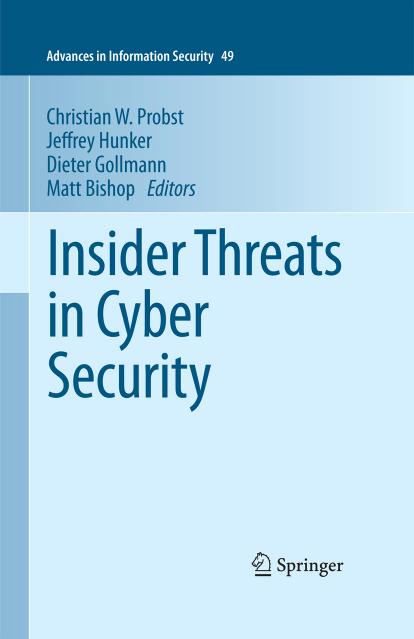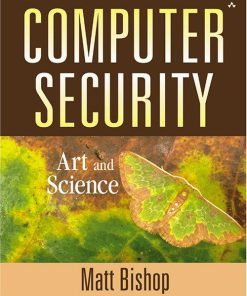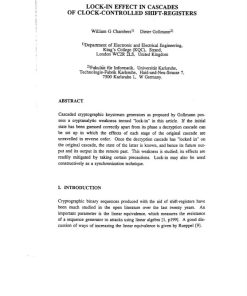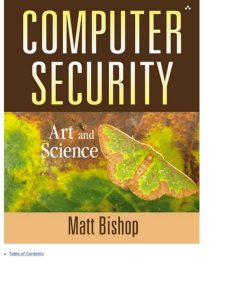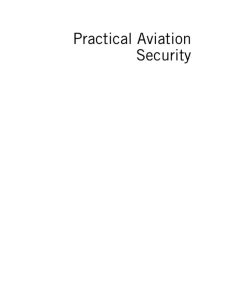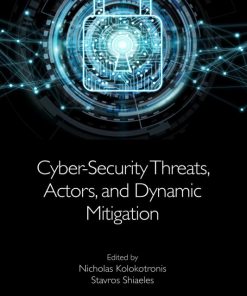Insider Threats in Cyber Security 1st Edition by Christian W Probst, Jeffrey Hunker, Dieter Gollmann, Matt Bishop ISBN 1441971335 9781441971333
$50.00 Original price was: $50.00.$25.00Current price is: $25.00.
Authors:Christian W. Probst, Jeffrey Hunker, Dieter Gollmann, Matt Bishop , Tags:Computer Science; Systems and Data Security; Computer Communication Networks; Data Encryption; Information Systems Applications (incl.Internet); Data Structures; Cryptology and Information Theory and Computer Systems Organization and Communication Networks , Author sort:Christian W. Probst, Jeffrey Hunker, Dieter Gollmann, Matt Bishop , Languages:Languages:eng , Published:Published:Jul 2010 , Comments:Comments:Computer Science, Systems and Data Security, Computer Communication Networks, Data Encryption, Information Systems Applications (incl.Internet), Data Structures, Cryptology and Information Theory and Computer Systems Organization and Communication Networks
Insider Threats in Cyber Security 1st Edition by Christian W Probst, Jeffrey Hunker, Dieter Gollmann, Matt Bishop – Ebook PDF Instant Download/Delivery. 1441971335, 9781441971333
Full download Insider Threats in Cyber Security 1st Edition after payment
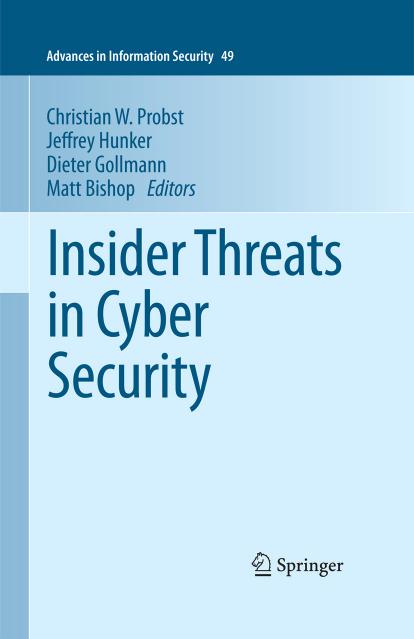
Product details:
ISBN 10: 1441971335
ISBN 13: 9781441971333
Author: Christian W Probst, Jeffrey Hunker, Dieter Gollmann, Matt Bishop
Insider Threats in Cyber Security is a cutting edge text presenting IT and non-IT facets of insider threats together. This volume brings together a critical mass of well-established worldwide researchers, and provides a unique multidisciplinary overview. Monica van Huystee, Senior Policy Advisor at MCI, Ontario, Canada comments “The book will be a must read, so of course I’ll need a copy.” Insider Threats in Cyber Security covers all aspects of insider threats, from motivation to mitigation. It includes how to monitor insider threats (and what to monitor for), how to mitigate insider threats, and related topics and case studies. Insider Threats in Cyber Security is intended for a professional audience composed of the military, government policy makers and banking; financing companies focusing on the Secure Cyberspace industry. This book is also suitable for advanced-level students and researchers in computer science as a secondary text or reference book.
Insider Threats in Cyber Security 1st Table of contents:
1 Introduction
2 Insiders and Insider Threats
2.1 Insider Threats
2.2 Taxonomies
3 Detection and Mitigation
4 Policies
5 Human Factors and Compliance
6 Conclusion
References
Combatting Insider Threats
1 A Contextual View of Insiders and Insider Threats
2 Risks of Insider Misuse
2.1 Types of Insiders
2.2 Types of Insider Misuse
3 Threats, Vulnerabilities, and Risks
3.1 Relevant Knowledge and Experience
3.2 Exploitations of Vulnerabilities
3.3 Potential Risks Resulting from Exploitations
4 Countermeasures
4.1 Specification of Sound Policies for Data Gathering and Monitoring
4.2 Detection, Analysis, and Identification of Misuse
4.3 Desired Responses to Detected Anomalies and Misuses
5 Decomposition of Insider Misuse Problems
5.1 Stages of Development and Use
5.2 Extended Profiling Including Psychological and Other Factors
6 Requirements for Insider-Threat-Resistant High-Integrity Elections
7 Relevance of the Countermeasures to Elections
8 Research and Development Needs
9 Conclusions
References
Insider Threat and Information Security Management
1 Introduction
2 Definitions of Insider and the Relevance to Information Security Management
3 Risk and Insiderness
3.1 The Importance of Organisational Culture and the Significance of Cultural Risks
3.2 Fieldwork on Culture and the Insider Threat
4 The Structure of the ISMS and Traditional Information Security Management Responses to Insiderness
4.1 Analysis Turning an ISMS Inwards
4.2 The Role of Operationalisation
5 Information Security Management Standards, Best Practice and the Insider Threat
5.1 General Security Management Standards
5.2 Guidelines Focused on the Management of the Insider Threat
5.3 Analysis of the Contribution of Best Practice and Guidelines
6 Crime theories and insider threat
6.1 Existing Connections between Crime Theories and Information Security Management
7 Implications of Crime Theories for ISMS Design
7.1 Application of SCP to the ISO Control Domains
7.2 Implications for ISMS Process Design
7.3 Summary of Crime Theory Contribution
8 Conclusions
References
A State of the Art Survey of Fraud Detection Technology
1 Introduction
1.1 Data Analysis Methodology
1.1.1 General
1.1.2 Procedure
2 Survey of Technology for Fraud Detection in Practice
2.1 General Approaches for Intrusion and Fraud Detection
2.2 State of the Art of Fraud Detection Tools and Techniques
3 Why Fraud Detection is not the Same as Intrusion Detection
4 Challenges for Fraud Detection in Information Systems
5 Summary
Acknowledgements
References
Combining Traditional Cyber Security Audit Data with Psychosocial Data: Towards Predictive Modeling
1 Introduction
2 Background
3 Issues of Security and Privacy
4 Predictive Modeling Approach
5 Training Needs
6 Conclusions and Research Challenges
7 Acknowledgments
References
A Risk Management Approach to the “Insider Threat”
1 Introduction
2 Insider Threat Assessment
2.1 Example
2.2 Summary
3 Access-Based Assessment
4 Psychological Indicator-Based Assessment
5 Application of Risk to System Countermeasures
5.1 Example
5.2 Summary
6 Conclusion
References
Legally Sustainable Solutions for Privacy Issues in Collaborative Fraud Detection
1 Introduction
2 Monitoring Modern Distributed Systems
2.1 Evidence Model
3 Observing Fraudulent Service Behaviours
3.1 Architectural Support
4 Introduction to the Legal Perspective
5 Basic Principles of Data Privacy Law
5.1 A Set of Six Basic Rules
5.1.1 Data Avoidance
5.1.2 Transparency
5.1.3 Purpose Specification and Binding
5.1.4 ProhibitionWithout Explicit Permission
5.1.5 Data Quality
5.1.6 Data Security
6 General Legal Requirements of Fraud Detection Systems
6.1 Privacy Relevance of Fraud Detection Systems
6.2 Necessary Data for Fraud Detection
6.3 Transparency in the Fraud Detection Context
6.4 Purpose Specification and Binding in Fraud Detection
6.5 Permissibility of Fraud Detection
6.6 Quality of Event Data
6.7 Security of Event Data
7 Technical Solutions for Privacy-respecting Fraud Detection
7.1 Technical Requirements
7.1.1 Requirements for Open Data
7.1.2 Specific Requirements for Pseudonyms in Open Data
7.1.3 Specific Requirements for Covered Data
7.2 Lossless Information Reduction with Covered Data
7.3 Lossy Information Reductions for Timestamps
7.3.1 Architecture and Algorithm
7.3.2 Limitations
7.3.3 Evaluation
8 Legal Improvements by Pseudonymizing Event Data
8.1 Technical Description
8.2 Privacy Relevance of Pseudonymized Event Data
8.3 Strengthening the Data Privacy Official
8.4 Disclosure With Legal Permission
8.5 Data and System Security
9 Conclusion
Acknowledgements
References
Towards an Access-Control Framework for Countering Insider Threats
1 Introduction
2 Motivation and related work
2.1 Illustrative scenarios
2.2 Definitions of insiders
2.3 Access control
2.4 The insider problem and access control
3 Trust, trustworthiness, and the insider problem
3.1 Insiderness
3.2 Trust management and risk assessment
3.3 Pragmatics of identifying suspicious events
4 Toward a contextand insider-aware policy language
4.1 Context and request predicates
4.2 Requirements
4.3 Policy transformations via declarative programming
4.4 Discussion of requirements
4.5 Policy transformations
4.6 Riskand trustworthiness-aware policy composition
5 Access-control architectures and the insider problem
6 Concluding remarks
References
Monitoring Technologies for Mitigating Insider Threats
1 Introduction
2 Related Research
3 Threat Model Level of Sophistication of the Attacker
4 Decoy Properties
5 Architecture
5.1 Decoy Document Distributor
5.2 SONAR
5.3 Decoys and Network Monitoring
5.4 Host-based Sensors
6 Concluding Remarks and Future Work
Acknowledgments
References
Insider Threat Specification as a Threat Mitigation Technique
1 Introduction
1.1 The Insider Threat Problem
2 Background
2.1 The Common Intrusion Specification Language
2.2 Panoptis
3 Insider Misuse Taxonomies and Threat Models
4 The Scope of the Insider Threat Prediction Specification Language
4.1 The Domain Specific Language Programming Paradigm
5 Conclusion
People also search for Insider Threats in Cyber Security 1st:
types of insider threats in cyber security
how to prevent insider threats in cyber security
two types of insider threats in cyber security
what are considered as insider threats in cyber security
define insider threats in cyber security
You may also like…
eBook CHM
Computer Security Art and Science 9th Edition by Matt Bishop ISBN 0201440997 9780201440997
eBook CHM
Introduction to Computer Security 1st Edition by Matt Bishop ISBN 0321247442 9788177584257
eBook PDF
Computer Security Art and Science 1st edition by Matt Bishop ISBN 013428951X 978-0134289519
eBook CHM
Introduction to Computer Security 1st Edition by Matt Bishop ISBN 0321247442 9788177584257

